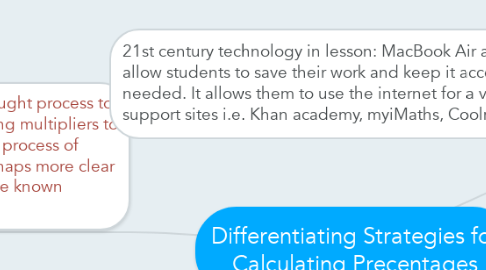Differentiating Strategies for Calculating Precentages
by Drew Wackerling

1. Student 2: Anna is a kinesthetic learner who is an abstract thinker and likes to draw out many of her thoughts and ideas on paper while she is in class. Often finds class discussions non-engaging and will be in her “own world” during class. Her comprehension of the content is excellent and mathematics is actually one of her favourite classes. She seems to be the type of person who never stops thinking and constantly has organisation problems with her school work and meeting deadlines. She usually sees things in a different light and can offer alternate ways of solving problems. She likes to illustrate them through her drawings.
2. Strategy for Learning 1: Give Anna the space to work on her own away from others in order to minimise distraction. She will illustrate the percentages by drawing images that correspond to comprehension of the content. An effort will be made to keep her engaged with continuous check-in’s, also to ensure that she is on the right track with her ideas to master the content.
3. Strategy for Learning 2: Allow her to present her images and thought process to the class. Give her the chance to clarify how she understands using multipliers to calculate growth and decay using percent’s. Through her unique process of learning other students can gain a different perspective and perhaps more clear understanding of the way to use percentages they might not have known otherwise.
4. 21st century technology in lesson: MacBook Air and iPads to allow students to save their work and keep it accessible when needed. It allows them to use the internet for a variety of support sites i.e. Khan academy, myiMaths, Coolmaths.com
5. Student 1: Alexander is a visual learner who is a very active gamer. He likes to mimic the process for completing his task through modeling in order to gain proficiency with the content. He suffers from ADHD and has a hard time staying focused in class for extended periods of time. He is very comfortable with computers and finds learning with them more engaging then from a book. His readiness is moderate but he is usually enthusiastic to learn. He is friendly, outgoing and popular with the other kids in the class. He receives extra time on summative assessments due to his condition and occasionally will be given reduced tasks to help him complete work on time.
6. Strategy 1:Allow Alex to use his laptop to complete his percentages work. He can utilize online support if I am not available at any given moment. By having the use of online tutoring sites, he can access videos in order to hear and see how to approach a certain part of the content he needs to master. It gives him a new perspective towards learning.
7. Strategy 2: Find percentage games online using various websites. Alex finds learning through gaming a better way of applying what he’s learned to real life situations. There are a variety of different game scenarios to keep him occupied during class. These activities should also vary in degrees of difficulty so that he may increase his skills to meet those of the standard the class is trying to reach.


